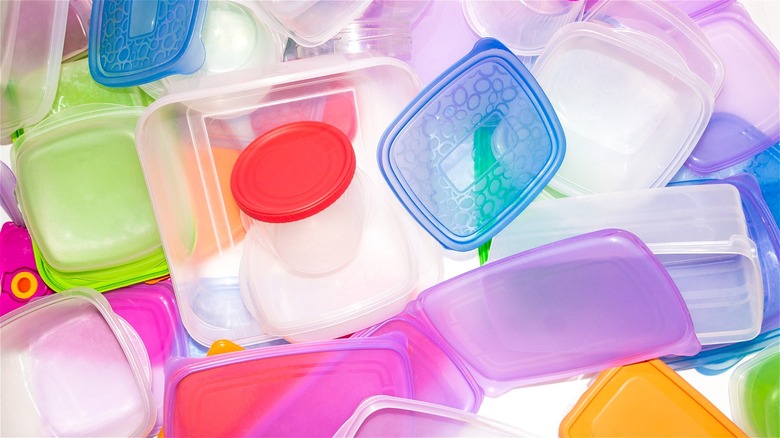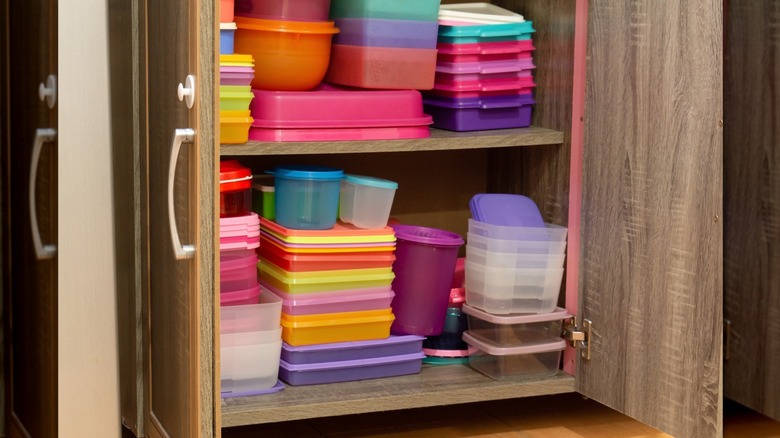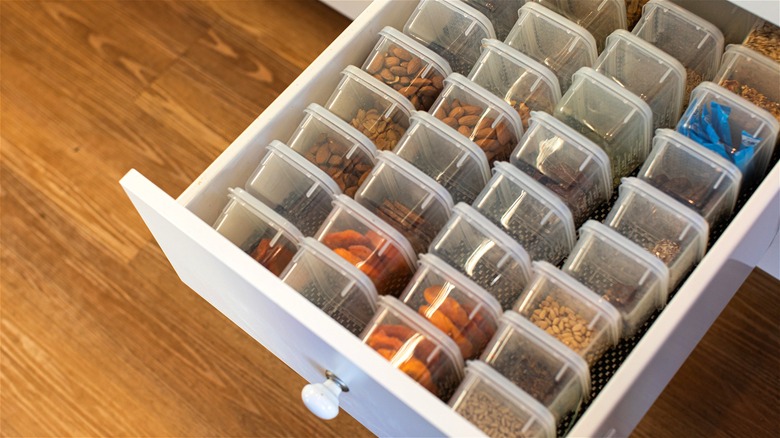Never Lose A Food Container Lid Again With One Genius Organization Hack
We've all been there. You've put leftovers in a storage container, but when you go to look for the lid, it's nowhere to be found. Should you keep searching till you go mad? Should you replace the lid with aluminum foil or plastic wrap? Neither option is ideal, and the whole situation is best avoided. Luckily, we have a genius hack to never lose a food container lid again.
The best way to keep tabs on your lids is to keep them well organized. And, with two inexpensive items, you can create your own storage system. All you need is a plastic bin and a cooling rack. Rest the cooling rack on top or inside of the bin, and secure it with glue or sticky tape if necessary. Your plastic lids should fit neatly into the slots. Mind you, the size of the plastic bin and cooling rack required depends on how many lids you're dealing with, so take note of your supplies before purchasing these items.
This organization hack makes your lids both easily accessible and highly visible. Then, if you place the storage bin in a cupboard or a large drawer, it will be out of sight until needed. When the time comes, you can quickly grab a lid without having to rummage through a messy pile. And now that we've gotten lid storage out of the way, we can tackle food containers. Let's be honest, we could always use more organization tips, so keep reading for the best ways to store food containers and how to stay tidy over time.
How to store food containers
Lids are only half the battle. You can't pride yourself on your pantry organization skills without having a storage system for food containers as well. Luckily, these are slightly more straightforward than lids.
Finding a place in your cupboards for all your food containers feels a bit like Tetris. To save precious space, stack similarly shaped items together, with larger items on the bottom. If you purchase containers of the same size and brand, they should fit perfectly on top of one another to maximize space.
Separating different types of containers provides a bit more of a challenge. Storage bins can come in handy by creating distinct sections. Alternatively, you can use flip book bins to create storage sections in drawers. Next, start to organize by separating food containers by shape or use; with mason jars in one bin, and shallow rectangular containers in another. Choose bins that work for each of these items and fit in your pantry. Also, if you're dealing with low cupboards, consider installing a sliding storage tray. This way, you won't have to get on your hands and knees to reach into the depths of the cupboard.
Keeping up with pantry organization
It's easy to keep things organized in the short run. It's after months of use that things start to go awry; a lid breaks, a container gets misplaced, and pretty soon, you're back where you started. You can't seem to find a matching container and lid to save your life. So, how do you keep up-to-date on your container organization?
When it comes to pantry organization, experts recommend minimalism. Be realistic about how many storage containers you need. If your pantry is overflowing with unused containers, it's time to pare down. Consider which ones you utilize frequently and make sure to keep various types of food storage containers for different uses. There's no sense in tossing the ones you don't need. Donate them to a charity or use them to gift baked goods to friends.
Our next tip involves re-organizing your kitchen storage periodically. Frequency should depend on just how quickly things get messy, but in general, we recommend every 2-3 months. When you start to notice things are out of place, do a deep cleaning and take inventory of your supplies. Make sure nothing is broken and that all containers have a matching lid and vice versa. Lone lids may be a lost cause, but unmatched containers can be repurposed into bowls, spice organizers, or art supply holders.


